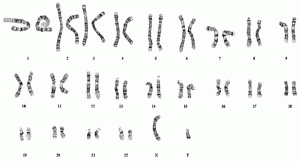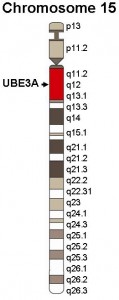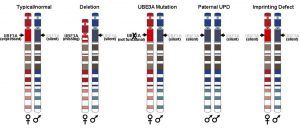Genetics 101
Introduction
The following is a very general explanation of Angelman syndrome written for parents. For a more sophisticated explanation of AS, see the About Angelman Syndrome section in this website. Angelman syndrome (or AS) is caused by the lack of function of one specific gene, called UBE3A. To understand this, we first need to understand how chromosomes and genes work together to allow our brains to function. A typical person has 46 chromosomes inside every cell in their body. We inherit 23 chromosomes from one parent and 23 from the other. Chromosomes are like the instruction manuals containing all the detailed information our cells need in order for our brains and bodies to grow and function. Chromosomes are numbered like volumes in a set of encyclopedias. We inherit one copy of each chromosome from each parent, giving us two copies of each chromosome. We all have two copies of the chromosomes numbered from 1 to 22, plus a sex chromosome inherited from each parent. This is a karyotype, or map, of the human chromosomes. You can see each set of chromosomes matched up from biggest (chromosome 1) to smallest (chromosome 22). We can think of each chromosome as a volume in an encyclopedia with two copies of each chromosome.
Our genes are like the individual topics in the set of encyclopedias. Different genes are located in each chromosome the way that information might be organized in an encyclopedia. Scientists only understand a fraction of how our genes help cause good health or disease and exactly how each gene functions.
It is likely that we all have a number of genetic errors in our chromosomes. This is one reason why it is good that we have two of each chromosome to draw from: if one chromosome has an error, our cells can easily get the information they need from the second chromosome. Nature has provided us with a great back-up system to ensure our cells always have the instructions they need for our brains and bodies to function even when there are inevitable errors in our chromosomes.
The important chromosome for Angelman syndrome is number 15. This chromosome has a region that is "imprinted." Imprinting means that some genes on the chromosome are "turned on" or "turned off" depending on which parent contributed the chromosome. Going back to the set of encyclopedias, imagine that we have two versions of the 15th volume, but a chapter in the volume inherited from the father has been washed out and the "pages" are now blank. Similarly, a different chapter in the volume from the mother is washed out and the pages appear blank. Imprinting occurs at the time of conception as part of the normal development of the fetus and each of us have regions on some of our chromosomes that are imprinted, meaning that only one parent's genetic information is available to our cells as instructions on how to grow and develop. In imprinted regions of our chromosomes, only one parent's information is accessible to cells in the brain and body, so there is no back-up system if there is an error in the remaining chromosome.
This is a karyotype, or map, of the human chromosomes. You can see each set of chromosomes matched up from biggest (chromosome 1) to smallest (chromosome 22). We can think of each chromosome as a volume in an encyclopedia with two copies of each chromosome.
Our genes are like the individual topics in the set of encyclopedias. Different genes are located in each chromosome the way that information might be organized in an encyclopedia. Scientists only understand a fraction of how our genes help cause good health or disease and exactly how each gene functions.
It is likely that we all have a number of genetic errors in our chromosomes. This is one reason why it is good that we have two of each chromosome to draw from: if one chromosome has an error, our cells can easily get the information they need from the second chromosome. Nature has provided us with a great back-up system to ensure our cells always have the instructions they need for our brains and bodies to function even when there are inevitable errors in our chromosomes.
The important chromosome for Angelman syndrome is number 15. This chromosome has a region that is "imprinted." Imprinting means that some genes on the chromosome are "turned on" or "turned off" depending on which parent contributed the chromosome. Going back to the set of encyclopedias, imagine that we have two versions of the 15th volume, but a chapter in the volume inherited from the father has been washed out and the "pages" are now blank. Similarly, a different chapter in the volume from the mother is washed out and the pages appear blank. Imprinting occurs at the time of conception as part of the normal development of the fetus and each of us have regions on some of our chromosomes that are imprinted, meaning that only one parent's genetic information is available to our cells as instructions on how to grow and develop. In imprinted regions of our chromosomes, only one parent's information is accessible to cells in the brain and body, so there is no back-up system if there is an error in the remaining chromosome.
 This illustration of Chromosome 15 highlights in red the section that contains the UBE3a gene and is often deleted from the maternal chromosome in Angelman syndrome.
There are many mechanisms that cause what is known as Angelman syndrome. The most common is a "deletion." If the 15th chromosome is like a volume in an encyclopedia, with a special chapter that is only in the volume inherited from the mother, then imagine that chapter has been torn out. This is a bit similar to how most people with Angelman syndrome have a deletion in their chromosome 15. There is a missing chapter in their volume so the brain is missing some of the instructions it needs to grow and develop. The father's chapter is present but was "washed out" due to the natural process of imprinting so the pages appear blank and the cells in the brain can't access the information.
Other individuals with Angelman syndrome have a mutation in the UBE3A gene. This is similar to having a mis-spelling in the important chapter that is only present on the chromosome inherited from the mother. This mis-spelling is so severe that it makes much of the chapter illegible to cells in the brain. Again, the end result is that the brain lacks important information to learn and develop.
Some people with Angelman have uniparental disomy or UPD. In these cases, the individual inherited two copies of this "volume 15" from the father and no copy from the mother. Again, the information that is only in the volume inherited from the mother is missing and both copies from the father are blank or "washed out".
A small number of individuals with Angelman have an imprinting centre (IC) defect on the maternal chromosome. There is a region on the 15th chromosome that helps the chromosome decide whether the chapters of information are accessible or "washed out". When there is a defect in the maternal IC, the chapters that are normally accessible become inaccessible. Even though the "volume 15" is complete and normal, the cells in the brain can't access the information that they need.
This illustration of Chromosome 15 highlights in red the section that contains the UBE3a gene and is often deleted from the maternal chromosome in Angelman syndrome.
There are many mechanisms that cause what is known as Angelman syndrome. The most common is a "deletion." If the 15th chromosome is like a volume in an encyclopedia, with a special chapter that is only in the volume inherited from the mother, then imagine that chapter has been torn out. This is a bit similar to how most people with Angelman syndrome have a deletion in their chromosome 15. There is a missing chapter in their volume so the brain is missing some of the instructions it needs to grow and develop. The father's chapter is present but was "washed out" due to the natural process of imprinting so the pages appear blank and the cells in the brain can't access the information.
Other individuals with Angelman syndrome have a mutation in the UBE3A gene. This is similar to having a mis-spelling in the important chapter that is only present on the chromosome inherited from the mother. This mis-spelling is so severe that it makes much of the chapter illegible to cells in the brain. Again, the end result is that the brain lacks important information to learn and develop.
Some people with Angelman have uniparental disomy or UPD. In these cases, the individual inherited two copies of this "volume 15" from the father and no copy from the mother. Again, the information that is only in the volume inherited from the mother is missing and both copies from the father are blank or "washed out".
A small number of individuals with Angelman have an imprinting centre (IC) defect on the maternal chromosome. There is a region on the 15th chromosome that helps the chromosome decide whether the chapters of information are accessible or "washed out". When there is a defect in the maternal IC, the chapters that are normally accessible become inaccessible. Even though the "volume 15" is complete and normal, the cells in the brain can't access the information that they need.
 This illustration shows the different mechanisms that cause Angelman syndrome. The red chromosomes represent the chromosome inherited from the mother while blue represents the father. The first example shows a normal pair of "volume" 15s with the father's chromosome chapter with UBE3A "washed out" or silent, while the mother's chapter is active and UBE3A is expressed, making the genetic instructions in that area available to the cells in the brain. The remaining examples illustrate the known mechanisms that cause Angelman syndrome by making the mother's genetic information inaccessible to the cells in the brain. For example, in deletions, the UBE3A gene is completely missing as that "chapter" has been "torn out". In UBE3A mutations, the UBE3A gene is "mispelled" which makes this copy of UBE3A non-functional.
Lastly, a few individuals have all or most of the symptoms of Angelman syndrome, but every test of their genes turns out normal. In many of these cases, it is likely that we just don't yet have the technology and expertise to understand what is wrong, but additional research is likely to reveal new causes of AS, which will help these families understand what is causing Angelman syndrome in their loved one(s).
Scientists are still trying to understand what exactly the UBE3A gene does. All we know for sure is that UBE3A is vital to how the brain develops and controls speech, movement and learning. When the UBE3A gene is blocked from functioning normally, the individual has Angelman syndrome. UBE3A is a gene that is also being investigated for a role in autism and genetic disorders like Isodicentric 15. Research into future treatments and cures for Angelman relies on finding a way to make the UBE3A present in the paternal "volume" available to the brain. Essentially, if we think of the genetic information on the father's chromosome as being "washed out" and invisible, scientists are searching for ways to make the data reappear so that the brain can access the information and individuals with AS can develop to their fullest potential.
This illustration shows the different mechanisms that cause Angelman syndrome. The red chromosomes represent the chromosome inherited from the mother while blue represents the father. The first example shows a normal pair of "volume" 15s with the father's chromosome chapter with UBE3A "washed out" or silent, while the mother's chapter is active and UBE3A is expressed, making the genetic instructions in that area available to the cells in the brain. The remaining examples illustrate the known mechanisms that cause Angelman syndrome by making the mother's genetic information inaccessible to the cells in the brain. For example, in deletions, the UBE3A gene is completely missing as that "chapter" has been "torn out". In UBE3A mutations, the UBE3A gene is "mispelled" which makes this copy of UBE3A non-functional.
Lastly, a few individuals have all or most of the symptoms of Angelman syndrome, but every test of their genes turns out normal. In many of these cases, it is likely that we just don't yet have the technology and expertise to understand what is wrong, but additional research is likely to reveal new causes of AS, which will help these families understand what is causing Angelman syndrome in their loved one(s).
Scientists are still trying to understand what exactly the UBE3A gene does. All we know for sure is that UBE3A is vital to how the brain develops and controls speech, movement and learning. When the UBE3A gene is blocked from functioning normally, the individual has Angelman syndrome. UBE3A is a gene that is also being investigated for a role in autism and genetic disorders like Isodicentric 15. Research into future treatments and cures for Angelman relies on finding a way to make the UBE3A present in the paternal "volume" available to the brain. Essentially, if we think of the genetic information on the father's chromosome as being "washed out" and invisible, scientists are searching for ways to make the data reappear so that the brain can access the information and individuals with AS can develop to their fullest potential.
This article was authored by Rebecca D Burdine PhD and Erin Sheldon. Reviewed for accuracy by Wen-Hann Tan, BMBS Children's Hospital Boston, Boston MA All articles, quotes and materials are copyrighted ©. Copyright protected worldwide all rights reserved. This article can be copied or distributed for educational purposes only, but must not be altered in form or content.
The Content above is for informational purposes only, it is not a substitute for professional medical and or therapeutic advice, diagnosis, and/or treatment. Do not attempt to implement therapies without first seeking the advice of a professional therapist or medical provider as treatment has many consequences that must be medically and therapeutically addressed.